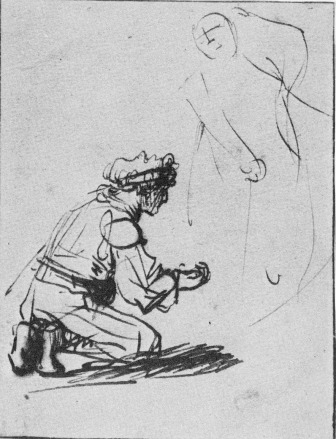Despite my forays into educational writing like this, I have never been an FTO.
Field Training Officers or preceptors are responsible for training and supervising new hires, who typically work for several weeks as an additional third crewmember (or “third rider”) while learning the ropes. For various reasons, I’m not sure I’d be good at this, and I’ve never pursued it. On the other hand, regardless of what I want to pursue, I’ve never been able to avoid working with new partners.
By “new,” I mean minty-green new — folks who have never worked on an ambulance, or in some cases, never worked a job at all. Since this kind of EMT is usually paired with a fairly senior partner early on — and since not many people stick with this job long enough to be “senior” — if you’ve been doing this for a few years, you’ll usually wind up with a new guy sitting next to you. It is what it is.
Standard operating procedure is to drink lots of coffee, grumble, boss them around, and let them gradually absorb whatever useful knowledge you inadvertently leak out. Unfortunately, this is both stressful for the new guy, and something less than fully enriching; they learn as many bad habits as good practices, and become jaded faster than they become competent.
I am not a gifted teacher when it comes to in-person training. But like most things in this job, by learning it the hard way, I’ve developed some useful insights. So here are a few pointers for bringing along your new guy and molding them into the very bestest EMT they can be.
Make your expectations clear
For you, it’s Wednesday, you’re tired, and for some reason your left knee keeps clicking. But for them, it’s their first day on an ambulance, and everything is new.
The best thing you can do is to clarify how this game is going to work. What’s going to happen when you walk into a call? How are you going to assign responsibility? What do they know, what do they need to know, and how will that process occur?
I once punched in to find a partner I hadn’t met before. Ten minutes into checking the truck, we got sent out to a seizure at the department store. I drove, she teched. But each time I tried to let her “do her thing,” she just froze like a deer in headlights. Turned out, this was the first shift she’d worked — ever — and her entire training period had been spent running routine transfers. She wasn’t just unpracticed, she hadn’t even seen most of what takes place on an emergency call, never mind attempted it.
Although you could call this a gross failure of the training process (I did), the underlying lesson is that you never know what you’re dealing with. Your partner may have years of experience at another service; he may have just finished high school and never worked a full-time job; he might be a new EMT, but just spent twenty years as a veteran CNA. Maybe he’s a few months in, comfortable with certain situations, but wholly new to others. You need to know where they’re coming from. Not only will they resent the stress and panic induced by stranding them when they don’t know what to do, but they’re just as likely to resent your butting-in (whether explaining something or actually taking over) when they do know what to do; the dividing line can be nearly invisible, but is very real.
Some points to consider:
- Who drives? Many seniors tend to do most of the driving while their newbie techs in back. The theory here is that you should “learn the back before you learn the front” — that is, patient care before driving and navigation. I find this arbitrary, since driving is as important to this job (and sometimes as difficult to do well) as anything else. It’s reasonable to focus on one skillset before developing the other, but I think driving should start early, because eventually they’re going to be forced into it anyway (driving for an ALS unit, perhaps), and they need to be ready. Start almost immediately by letting them drive between calls on routine matters; this acclimates them to handling the ambulance and navigating your service area. Once they’ve figured that out, they can do some emergency driving on responses. When you’re comfortable they can safely get from Point A to Point B, let them drive while occupied with patients — if they know where they’re going, or at least have a reliable GPS. But don’t throw them into this without some instruction on how to drive smoothly and safely, or you’ll spend the trip getting angry while you slide around the bench, and they won’t know why.
- Who does what on emergency scenes? Working with experienced partners, I cleave to the golden rule: the tech runs the call, while the driver shuts up and helps out. This makes it easy to avoid stepping on each other’s toes or going different ways. If you’re the tech and your new partner is driving, this still works, because you’ll make the calls and tell them what to do, and they can watch your amazing wizardry in action. But what if they’re the tech? I always try to let them take the reins, but if they pulled the tags off their first uniform yesterday, they’re probably just going to stand there. I give ’em a few beats and then take over (you can’t stand there forever staring at the patient). But between calls, go over what needs to happen, and try to gradually work them toward familiarity with their role.
- How will feedback be given? Like in any relationship, communication is only ever bad when it’s not undertaken promptly and directly. From day one, make it clear that if they ever have a question, they should ask it (at the appropriate time); if they’re ever uncertain, they should request assistance (you’ll only be mad when they screw up because they didn’t ask); and if they want help, you want to provide it. Conversely, explain that after calls you’ll give suggestions and feedback, which should be taken constructively; they have a lot to learn and must embrace that. If you tend to adopt a direct or brusque manner, as many of us do, warn them that it’s not personal and you’re not rebuking them, you’re just too old and tired to sugarcoat everything. Reassure them that you’ll never talk shit to others when they mess up; when anybody asks, you’ll just make vague remarks like “oh yeah, he’s good.” Above all, remind them that although you’re here to support them, patient care comes first, so there will be times when “teachable moments” need to take a back seat.
Practice, Practice, Practice
The main problem for most new folks isn’t “knowledge,” it’s application. They may have memorized the EMT textbook (although that book, of course, is a little light), but there are a thousand tiny things that comprise the everyday functioning of this job, and they know none of it.
That’s one of the goals behind Scenarioville. To get good at this job, you need practice. And even in a busy system, in a given week you may only do one or two seizures, or drunks, or chest pains, or any other type of call, with a lot of other stuff in between. If they’re weak with something, it takes a long time to to practice enough to get any better.
You can fill that gap with drills, as realistic as possible. In your downtime, make ’em go through the paces. Trouble giving radio patches? Hand ’em the mic (turn it off first) and have ’em pretend they’re talking to the hospital, complete with pressing the right buttons and hearing static-filled replies from you. Do they need to practice driving? Find a parking lot and give them tasks to accomplish, such as backing in a straight line, turning corners, or navigating tight gaps. Bad at lifting? Give ’em workout homework (get thee to the gym and start deadlifting!). Watched them fumble with a skill? Make ’em do it: take a blood pressure off you (with various locations, sizes, and methods), assemble the nebulizer or apply a dressing, or execute a thorough neuro, abdominal, or trauma assessment. In some cases verbalizing a skill is all you can manage, but whenever possible, do it for real; a disposable neb is a small cost to pay for skill mastery, and the first time they open the package shouldn’t be on a sick person.
If they’re interested, you can certainly chat about deeper medical topics like V/Q mismatching and the citric acid cycle. But they can get that from a book. When it comes to practice, something more interactive is needed. Often, I’ll do verbal scenarios, describing a call and forcing them to make decisions as they go. Nothing is quite as frightening as a totally unscripted, unstructured situation, where you stop and stare and ask, “What do you do?” And don’t let them get away with vague invocations like “scene safety” or “manage the airway”; force them to describe exactly what they mean. Oh, you’ll check for a pulse? How? Where? What are you looking for? Okay, where’s that piece of equipment? How do you size it? Are you sure we’ve got one?
History-taking is the most difficult skill to acquire. Force them to talk directly to you as if you were the patient, because they need to be comfortable with that. With experience, you develop a patter, and you have go-to lines at each juncture — what you say in greeting, what to ask for certain complaints, how to unpack certain responses. They haven’t acquired those moves yet, but they need to develop them, so by presenting them with those situations in a practice setting, they have a low-stress way to hone their own tools.
Every new partner I’ve had has gone through a similar learning curve. At first, they don’t know anything. After a while, the first things they get comfortable with are the “skills,” simple, concrete tasks they know how to execute. As a result, when they walk into a scene and don’t know what to do, they immediately start doing whatever task they’ve mastered — taking a blood pressure, writing down meds, etc. The challenge is getting them to move beyond rote psychomotor skills to the nuanced business of actually approaching the patient, greeting them, assessing them medically with questions and focused physical examination, deciding what’s wrong, and making decisions accordingly. This is tough, and occasionally I’ve had to take things away from people (cuffs, glucometers, nasal cannulas, pens) so they couldn’t “hide” in them.
In the end, the key to mastery is repetition. A single repetition is nothing. When the two of you run a call and you realize they need to practice something, debrief afterward by discussing the details, make them describe the considerations and goals, and spend the rest of the day verbalizing scenarios similar to the call you did. Once they’re absolutely sick of it, you’re starting to make progress, because boredom means they know what to do, and that’s the whole idea.
Managing your own blood pressure
One of the biggest challenges, of course, is not losing your mind.
Even smart students will sometimes drive you out of your gourd. Usually, this is because they don’t know something you figure they should. In fact, everybody should know that. In fact, how in god’s name can you be old enough to drive a car without being able to figure this out? It’s common sense!
The trouble is, it isn’t common sense. When you started out, you had to learn it. But that was so long ago, you’ve forgotten how much you originally had to learn; many of the routine aspects of the job are now second-nature to you. But they’re not second nature to your partner; he has to consciously learn them all, and think about them when he does them, and he can only internalize so many at a time. So while he’s trying to remember to do X, Y, and Z, he might forget A and B. Even if A is something that he does know. And maybe he never even learned C. See?
When they develop confidence, they improve exponentially, because once they relax they can actually think; most dumb stuff is the result of blind panic. (The secret of veteran providers is that they often don’t know what to do, but they use their noodle and do what makes sense. This isn’t a difficult skill, but you can’t do it while holding your breath.)
My own pet peeve is when I tell ’em something, and next week tell ’em again, and six months later I swear I’m telling ’em the same thing, and they’re staring at me like they’ve never heard it. Ain’t you listening to me, Jethro? Well, they are listening. But I’ve also been talking a whole lot, and between the V/Q mismatches and everything else, they’re not going to remember all of it; it’s going in one ear and most of it out the other. So either I can slow the flow a little, or expect to repeat myself. Either way, my problem, not theirs.
The point is that there’s a great deal to learn just to master the basics of this job, never mind acquiring true clinical acumen. Combined with the fact that many new hires are young, and haven’t developed the general problem-solving skills that only come with years and failures and overall life experience (being a good employee, talking to other humans, empathizing with suffering, avoiding dangerous situations, and so on), and you get a perfectly intelligent person who sometimes seems like they’ve had a lobotomy.
Take deep breaths, try to remember what it was like when you were in their shoes… and warn them early that you will occasionally get fed up, sometimes act short, and at the 15th hour of a shift, will not always be gentle Grandpa Patience. Advise them that you’re not perfect and will not always act out the principles you espouse. And request that, although you like to teach and you like your job, when you’ve been working for 60 hours straight you may need some quiet time.
Most of all, look around at all your competent coworkers who once upon a time made their partners pull out their hair and ask whether they were working with a trained monkey. Because it does get better, and years ago, that monkey was you.




Recent Comments